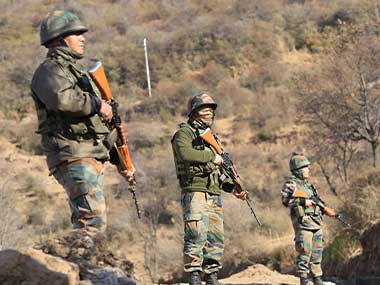Editor’s note: With Jammu and Kashmir under Governor’s Rule for the eighth time, Firstpost is running a series of reported pieces, analytical articles and commentary to track the progress of events in the state.
New Delhi: Security forces began redeploying personnel for focused, information-based anti-terror operations Wednesday even as intelligence agencies warned of attacks ahead of the Amarnath Yatra in Jammu and Kashmir. Intelligence analysis reviewed by Firstpost suggests the Lashkar-e-Taiba (LeT), Jaish-e-Mohammed (JeM) and Hizbul Mujahideen (HM) have considerably stepped up activities in south Kashmir, especially in Shopian, Anantnag, Budgam, Kulgam and Pulwama and are using sleeper cells to mobilise potential attacks during the Amarnath Yatra, which starts from 28 June.
This intelligence analysis, which is over 20 pages, is the first since the Bharatiya Janata Party (BJP) — claiming a steep rise in terrorism, violence and radicalism in Jammu and Kashmir — pulled out of an alliance with the Peoples Democratic Party (PDP). The alert warns of an increase in potential attacks against security forces in the coming days and aggressive counter-terror operations are being planned to neutralise threats. The intelligence analysis decoding chatter from across the border further observed that political activists could become soft targets for Pakistan-sponsored terrorists to disrupt peace and trigger chaos in the Valley.
“There is a possibility of terrorists sneaking into the hideouts along the national highway to regroup and carry out attacks,” a source in the security establishment said. “Preventing such attacks requires collective effort between law enforcement and intelligence units to effectively wipe out terrorists. Two back-to-back intelligence based operations in the first week of June in Machhil and Keran sector suggest JeM and LeT have intensified infiltration. We have launched focussed operations along the traditional infiltration route to foil terrorists as well as cordon-and-search operations in the areas suspected to be terrorist hideouts.”
Security forces may also launch intense manhunts in Rampora, Baan, Yasoo, Furrah, Hawoora, Wanpoh and Panzath areas of Kulgam after intelligence inputs warned of concentration and movement of HM terrorists. Operations are also likely to be renewed in Heff Shirmal, Chak Chollan, Nagbal, Trenz and Zainapora after alerts about activities of HM and LeT terrorists. Intelligence reports also suggest redeployment of security forces in strength at suspected terrorist hideouts and creating synergy between various forces on the ground.
“Higher infiltration of militants from Pakistan this year has resulted in their increased numbers in the Valley despite a larger number being killed compared to the first half of last year. Security forces exercised maximum restraint in dealing with protesters in the Valley but suffering of border population due to increase in ceasefire violations by Pakistan has gone up,” the intelligence note observed.
According to data provided by the Ministry of Home Affairs, 2017 saw an increase in incidents of terror and civilian casualties compared to 2016. In 2017, 80 security forces personnel, 40 civilians and 213 terrorists were killed. In 2018, until mid-June, 38 civilians, 40 security personnel and 95 terrorists have been killed.
Former top policeman VN Rai told Firstpost the intelligence apparatus may be further strengthened in order to foil infiltration bids at the border and there is a possibility that such attempts may show some results. However, a renewed offensive in the Valley may not provide desired results and is likely to intensify terror attacks in the coming days.
“You need to defeat the designs of the Pakistan Army and Inter-Services Intelligence (ISI) to establish peace in the Valley,” Rai said. “Army and security forces are operating under a massive threat and I believe that sustained counter-terror operations may not be able to reduce terror-related violence. The whole situation reminds me of the days of Rajiv Gandhi regime. That vague policy resulted in a 10-year insurgency in the Valley. I think if the government is serious about containing terror in Kashmir, it should carry out operations across the border, launch pads and wherever they are. You need integrated efforts by our agencies and above all political will to meet the challenge.”
The intelligence note suggested expanding the action plan of human and technical intelligence to thwart terrorist activities across district boundaries in the Valley. It said, “Constant liaisons must be maintained with the state police and other agencies for sharing information and coordinating action. Any significant information in this regard should be immediately intimated to all concerned for targeted operations.”
Well-known internal security expert Ajai Sahni told Firstpost the situation is not as bad as the 1990s. We have seen targetted operations in the past two years to minimise civilian casualties and inflict maximum damage on terrorists, he added. He further said fatalities in 2017 increased but comparing it to 1990s and 2000s is not a wise way to examine the situation because they are a minuscule fraction in terms of incidents and fatalities. Sahni said in 2018, fatalities related to terror was limited to just 29 tehsils and just 5 tehsils accounted for 60 percent of killings which showed the spread of violence is diminishing.
“I don’t see any new approach. Anti-terror operations will continue sans any jingoism that we may witness in Delhi’s echo chambers. What we are going to witness is limited operations based on precise inputs and avoiding heavy cordon-and-search operations to prevent civilian fatalities. If you look at the number of civilian casualties in the past couple of years, it has declined considerably and the number of terrorists killed has has gone up. Even stone-pelting incidents dropped significantly compared to last year. This kind of narrow targeted operations, I believe, will continue as we have seen it yield successes in the past,” Sahni said.


)




)
)
)
)
)
)
)
)